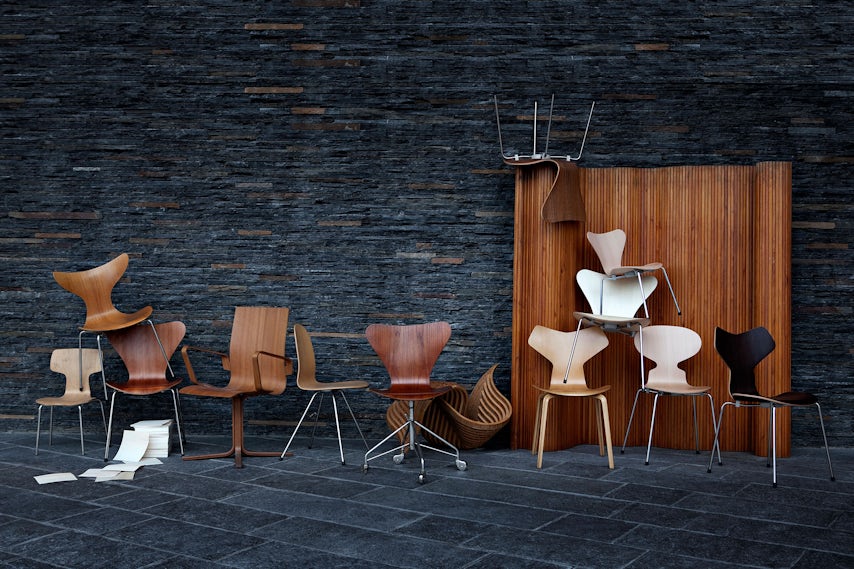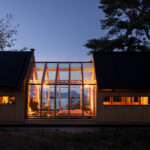He wanted to be a painter, but fortunately for Danish Modern aficionados, his father talked him into architecture instead. Like other architects of his time, he ended up creating bespoke fixtures and furnishings for his projects, many of which are still coveted and some that are frequently knocked off. On this day in 1902, Arne Jacobsen was born in Copenhagen, and the world gained such iconic objects as the Egg chair and VOLA faucet. Today, we’re celebrating the Danish architect with a look back at his lasting contributions to product design.
Ant (Fritz Hansen, 1952)
This odd, little three-legged piece began the long-lasting collaboration between furniture-maker Fritz Hansen and Jacobsen. Originally, the architect designed the Ant for the cafeteria at Novo Nordisk, a Danish pharmaceutical company, to offer the client something affordable, lightweight and stackable.

Its form, reminiscent of an ant raising its head, comprises bent plywood and tubular steel legs. Although the Eames plywood chair that furnished Jacobsen’s own studio was an obvious influence on this design, the Ant distinguished itself by using a single, continuous shell for the seat and back, which was characteristic of Jacobsen’s reductionist work during this period. Today, Ant comes in both three- and four-legged models.

Dot (Fritz Hansen, 1954)
Roughly about the time he was working on the Ant, Jacobsen developed this simple stackable stool. Its original design was realized in all veneer and with three legs, but nowadays it sports a walnut or beech seat and four tubular steel legs. Nine painted versions are also available.

Series 7, aka The Sevener (Fritz Hansen, 1955)
The top-selling chair produced by Fritz Hansen, however, was the Series 7, and to this day, it gets copied over and over. Unlike its predecessor the Ant, Series 7 was designed with four tubular legs from the get-go, a larger seat area and more curves and molds that made it easier for bodies to shift position. The chair was also offered in different models to suit different needs and spaces: side chair stacker, armchair and swivel chair on casters.

Today, the Series 7 comes in a range of stained wood but also colored wood, color lacquered veneer or upholstered and in barstool, counter stool, stacker, swivel and children’s models.

Munkegaard (Louis Poulsen, 1955)
Minimal and flat, this disk-shaped semi-recessed ceiling fixture resembles many of today’s flatter designs that have been made possible thanks to LED technology. The white-opal glass diffuser — with a trim ring in high luster or satin chrome — casts a soft uniform light. Today, Munkegaard comes in three sizes and takes LED lamping.

Series 3300 (Fritz Hansen, 1956)
It’s widely known that Jacobsen furnished his SAS Royal Hotel and Terminal in Copenhagen with some of his most-admired seating designs. While most people primarily recall his shapely Egg and Swan chairs, there was also this handsome chair and sofa series, which was more about clean lines, angles and proportion. One-, two- and three-seat models are available in a range of fabric or leather upholstery options. The frame is constructed with chromed steel tubes.

AJ Doorknob (D Line, 1956)
Specifically designed for the SAS Royal Hotel, the AJ Doorknob is a lever-style handle with sculptural contours that seem to perfectly fit and fill the hollow of one’s hand.

Grand Prix (Fritz Hansen, 1957)
What set the Grand Prix apart from Jacobsen’s other plywood chairs was that it had an all-wood design (inclusive of the legs). Shown at the XI Triennale in Milan, it received the festival’s highest award, the Grand Prix, consequently how it got its name.

Originally, the seat was available in beech, teak or upholstered with a laminated beech frame, but it was later discontinued. Fritz Hansen has since revived it, however, in ash in nine colors or oak or walnut and with wood or tubular steel legs. The seat face can also be padded.

To celebrate the relaunch of Grand Prix in its original version with wooden legs, the Fritz Hansen store in Milan mounted an exhibition under the direction of Italian designer Diego Grandi in collaboration with tattoo artist Pietro Sedda. Photo by Delgino Sisto Legnani.
AJ Cutlery (Georg Jensen, 1957)
This sleek flatware line is so minimal and different that it was controversial for its time. It even made a cameo in the Stanley Kubrick masterpiece “2001: A Space Odyssey.” The units — a dinner fork and knife, salad fork, soup spoon and teaspoon — are made of matte-finish stainless steel.

AJ Lamp (Louis Poulsen, 1957)
Straight lines and oblique angles reminiscent of his 3300 seating line define the AJ lighting series. Available in table, floor and wall sconce versions, the lamp provides downward-directed light. Their adjustable shades are made of spun steel finished in blue/green, petroleum, red, sand, yellow/green, black, graphite or white.

Egg (Fritz Hansen, 1958)
This much-loved “friendly” chair furnished the lobby and reception areas of the SAS Royal Hotel, a project in which Jacobsen had the opportunity to integrate design on a smaller scale with architecture for a more cohesive, total design. In fact, he designed everything down to the knobs on the hotel’s shade cords.

© Egon Gade
The swivel lounge chair, which practically envelops the sitter, is fully upholstered in fabric or leather on a four-prong star base. An optional matching footrest is also available.

Swan (Fritz Hansen, 1958)
Also gracing the SAS Royal Hotel, the Swan was another upholstered chair that has found favor with the design community. At the time, the chair was offered in a swivel model but also a wood-leg version.

Today, it’s available only as a swivel on a four-prong star base but is nevertheless popular. The seat shell comes in a wide range of fabrics or leather. The Swan has a coordinating sofa model.

From left: The Swan series in the lobby of the National Bank of Denmark, a project by Jacobsen (note the floating stair, which was also meticulously designed by the architect); photos by Thomas Ibsen (left) and Søren Kuhn (center). The Swan in a Paul Smith edition, in collaboration with Maharam by Kvadrat.
Drop (Fritz Hansen, 1958)
The Drop was produced in a limited number exclusively for the SAS Royal Hotel project, but 50 years later, Fritz Hansen put it into production for the masses. Its embracing scoop-like shell is made of plastic in six colors or upholstered in fabric or leather, while its four legs are chromed or powder-coated steel tubes.

Oxford (Fritz Hansen, 1965)
While designing an extension for St. Catherine’s College in Oxford, the architect was asked to create a furniture collection for the project, as well. Out of this commission, the Oxford series was born. The chairs for the high (professor) table in the dining hall initially featured extra-tall backs to emphasize authority and were realized in bentwood with a pedestal base composed of four pieces of steam-bent wood. A low-back armchair prototype was also produced for the project.

St. Catherine’s College, Oxford; photo by Egon Gade.
These days, the curves have been tweaked some for comfort, the base is a five-prong star or on casters and the low- or high-back seat is (fully or face) upholstered in fabric or leather.

Cylinda-Line (Stelton, 1967)
Yes, Jacobsen also designed ashtrays! (And they’re not like the ceramic ones your niece made for you.) His line of stainless steel hollowware is, as the name sounds, cylindrical in form, making them appear timeless — perfect gifts for modernists, today. The product family consists of a coffee pot, coffee press, teapot, creamer, sugar bowl, salt and pepper mills, salt and pepper shakers, a salad bowl, salad servers, coasters, serving tray, jug with ice lip, cocktail shaker, martini mixer, ice tongs, ice bucket and ashtray.

Vola (VOLA, 1968)
A favorite of many fellow architects and product designers, this collection of bathroom and kitchen fixtures and fittings was designed for Verner Overgaard of VOLA A/S when Overgaard approached Jacobsen about creating a wall-mounted faucet, an idea that was new at the time. What also made this collection revolutionary was that it introduced modularity allowing designers or clients to combine and configure components in different ways. Following Jacobsen’s death, his former assistant Teit Weylandt installed the faucets in one of his final building projects, the National Bank of Denmark.

VOLA’s initial offerings included a short and long fixed spout, swivel spout, handheld showerhead, handles, towel peg, toothbrush holder, soap holder and soap dispenser. VOLA continues to build on this product line today.

Lily (Fritz Hansen, 1970)
Launched at the Danish furniture fair, the Lily chair seems to have elements of the architect’s earlier chair designs with regards to curves and silhouette. It is currently available with or without arms and on four chromed steel legs or a swivel caster base and fully upholstered. The shell and armrests are constructed of pressure-molded veneer sheets.

© Ditte Isager









